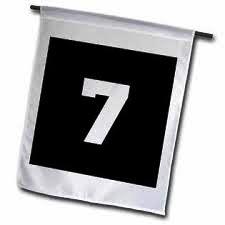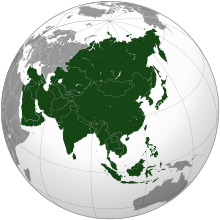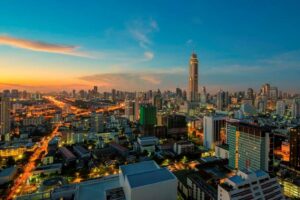» posted on Wednesday, August 3rd, 2022 by Linda Lou Burton
Number Seven
 Originally Published August 2, 2020 by Linda Lou Burton posting about Bangkok, Thailand from Little Rock, Arkansas – When I stepped off the plane at Bangkok’s airport yesterday, there should have been fireworks or marching bands. At the least I should have waved a little flag with Number 7 on it. Because, drum roll here, I was finally on Continent Number Seven! I was in my 60s before I ventured out of North America, with my trip to Antarctica via South America. And in my 80s when I got to Europe and Africa last year. Don’t wait that long to see the world! The world is a book and those who do not travel read only a page, Saint Augustine said a very long time ago. Travel is an eye-opener; it takes you out of yourself, I believe, and gives you more space for living your life. So, as soon as the lid on travel due to COVID-19 is lifted, get out and go. Meanwhile, it doesn’t hurt to imagine, and to learn about the rest of the world, as I am doing with my NDI RTW.
Originally Published August 2, 2020 by Linda Lou Burton posting about Bangkok, Thailand from Little Rock, Arkansas – When I stepped off the plane at Bangkok’s airport yesterday, there should have been fireworks or marching bands. At the least I should have waved a little flag with Number 7 on it. Because, drum roll here, I was finally on Continent Number Seven! I was in my 60s before I ventured out of North America, with my trip to Antarctica via South America. And in my 80s when I got to Europe and Africa last year. Don’t wait that long to see the world! The world is a book and those who do not travel read only a page, Saint Augustine said a very long time ago. Travel is an eye-opener; it takes you out of yourself, I believe, and gives you more space for living your life. So, as soon as the lid on travel due to COVID-19 is lifted, get out and go. Meanwhile, it doesn’t hurt to imagine, and to learn about the rest of the world, as I am doing with my NDI RTW.
I was curious as to where in the world most travelers do tend to go and found a map based on data collected by the United Nations World Tourism Organization (UNWTO). It doesn’t show Antarctica numbers; when I was there in 2005 it was estimated that only 250,000 people had ever set foot there. People fly over it, from New Zealand and Australia in particular. And every year in recent times about 14,000 people get there on a cruise ship. But restrictions only allow 100 people to go ashore at any one time, so I’d say far less than half a million people have ever walked on Antarctic soil.
As you can see from the map, most tourists head for Europe or the US, but Asia racks up big numbers too, especially China. And Thailand! Especially Bangkok. In 2019, Bangkok ranked 1st (surpassing Paris and London) in Mastercard’s list of “Global Destination Cities” with over 22 million visitors annually. https://ourworldindata.org/tourism
So let’s focus on that chunk of the world for today.
Asia
 Asia is Earth’s largest and most populous continent, though it is a bit hard to define, as it shares the landmass of Eurasia with Europe, and the landmass of Afro-Eurasia with both Europe and Africa. But within politically drawn lines are about 17+ million square miles and roughly 4.5 billion people. Within those square miles is an expansive range of climates – the equatorial south, the subarctic and polar areas in Siberia, hot deserts in the Middle East, and a temperate center. And those 4.5 billion people represent an enormous variety of ethnic groups, cultures, environments, economics, historical ties and government systems. And don’t forget – Asia was the birthplace of the world’s mainstream religions: Buddhism, Christianity, Confucianism, Hinduism, Islam, Judaism, as well as many other religions.
Asia is Earth’s largest and most populous continent, though it is a bit hard to define, as it shares the landmass of Eurasia with Europe, and the landmass of Afro-Eurasia with both Europe and Africa. But within politically drawn lines are about 17+ million square miles and roughly 4.5 billion people. Within those square miles is an expansive range of climates – the equatorial south, the subarctic and polar areas in Siberia, hot deserts in the Middle East, and a temperate center. And those 4.5 billion people represent an enormous variety of ethnic groups, cultures, environments, economics, historical ties and government systems. And don’t forget – Asia was the birthplace of the world’s mainstream religions: Buddhism, Christianity, Confucianism, Hinduism, Islam, Judaism, as well as many other religions.
There are 49 countries in Asia. Thailand is the talk today.
Thailand
 Thailand is the 14th largest country by area in Asia, with 198,000 square miles divided into 76 provinces where 66 million people live. Once called Siam, it is bordered by Myanmar (once called Burma), Laos, Cambodia, Malaysia, the Gulf of Thailand, and the Andaman Sea.
Thailand is the 14th largest country by area in Asia, with 198,000 square miles divided into 76 provinces where 66 million people live. Once called Siam, it is bordered by Myanmar (once called Burma), Laos, Cambodia, Malaysia, the Gulf of Thailand, and the Andaman Sea.
Thailand is a constitutional monarchy and parliamentary democracy; however, in recent history, its government has experienced multiple coups and periods of military dictatorships. After WWII Thailand became a major ally of the United States, periodically alternating between democracy and military rule. The most recent coup in 2014 established its current and 20th constitution. Despite sporadic changes in leadership, Thailand has a high level of human development. Its manufacturing, agriculture, and tourism make it the 20th-largest economy in the world. The capital and largest city is Bangkok, a special administrative area.
Bangkok
 Over 8 million people live in Bangkok; 14 million in the surrounding metro area. The city covers 606 square miles in the Chao Phraya River delta in central Thailand. It began as a small trading post during the Ayutthaya Kingdom in the 15th century; today it is a regional force in finance and business. It is an international hub for transport and health care and is a center for the arts, fashion, and entertainment. It is known for its street life and cultural landmarks; also its red-light districts. Rapid growth and little urban planning have resulted in a haphazard cityscape and inadequate infrastructure. Too few roads and too many private cars have caused crippling traffic congestion and severe air pollution. The development of public transportation is attempting to solve the problem, but congestion is still an issue.
Over 8 million people live in Bangkok; 14 million in the surrounding metro area. The city covers 606 square miles in the Chao Phraya River delta in central Thailand. It began as a small trading post during the Ayutthaya Kingdom in the 15th century; today it is a regional force in finance and business. It is an international hub for transport and health care and is a center for the arts, fashion, and entertainment. It is known for its street life and cultural landmarks; also its red-light districts. Rapid growth and little urban planning have resulted in a haphazard cityscape and inadequate infrastructure. Too few roads and too many private cars have caused crippling traffic congestion and severe air pollution. The development of public transportation is attempting to solve the problem, but congestion is still an issue.
The Fun Stuff
Next post I’ll concentrate on the beautiful things I see in Bangkok, not a word about congestion, I promise! We’ll visit the temples, palaces, museums, and parks, and maybe, though I am not a shopper, some of the famous markets, such as Chatuchak Weekend Market, Sampeng Market, Yaowarat, and Phahurat night market.
Life on Number Seven awaits.
https://www.tourismthailand.org/Destinations/Provinces/Bangkok/219
